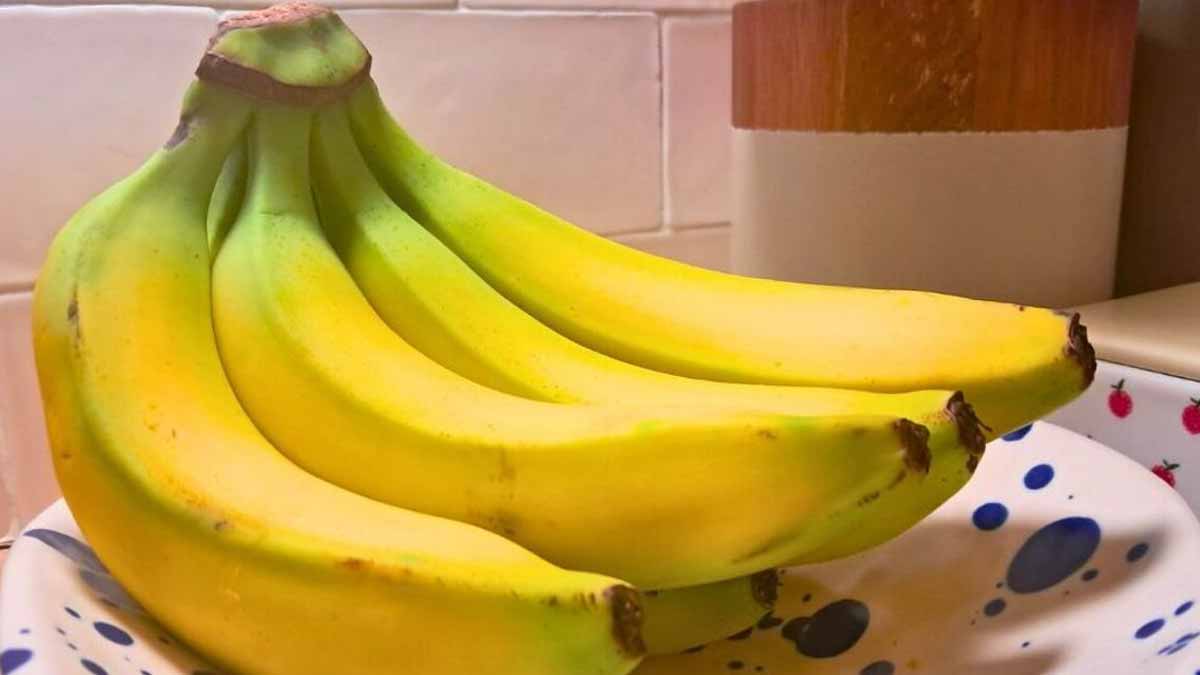Fresh for days, without tricks that waste time: here’s how to slow ripening with one simple gesture. The science is straightforward. The result is visible: a small wrap at the stems stops the cascade that softens and darkens bananas. You keep flavor, texture, and color longer, while avoiding waste and rushed snacks. The method is quick and works at room temperature. You can plan breakfasts and desserts without watching the fruit bowl every hour.
Why bananas ripen so fast
Ripening begins inside the fruit. Cells release ethylene, a natural hormone that triggers color change, softness, and sweetness. In a bunch, most of this gas escapes through the joined stems, then circulates around neighboring fruits. Once the concentration rises, the whole cluster ripens together, often faster than expected at home.
The stems act like a valve for ethylene. Gas concentrates at the junction, then leaks and spreads, which sets off a chain reaction along the bunch. That is why bananas sometimes look perfect one day, then spotty and soft the next. Even when you handle them gently at room temperature.
Temperature and neighbors matter. Warm rooms speed reactions, while direct sun warms peels and encourages spots. Nearby ethylene producers—apples, avocados, tomatoes—raise exposure further. In cramped fruit bowls, gas lingers around stems and accelerates softening. Smart storage changes that environment, slows the chemistry, and buys time without special equipment at home.
Wrap stems : the bananas method
Aluminum foil solves the problem with a tiny barrier. Wrap a small piece tightly around the joined stems and press to seal the junction. The cover limits ethylene escape where it starts, so the signal that speeds softening never floods the bunch. This simple step takes seconds and costs little.
When sealed well, freshness lasts noticeably longer. Many home tests show roughly five extra days beyond typical counter life. Because ethylene stays near the stems instead of circulating. Texture holds, flavor stays bright, and color changes more slowly. You stop the rush to eat everything at once, and reduce waste.
Want the maximum window? Separate the fruits and wrap each stem individually. Isolating the sources of ethylene keeps gas events local, so neighboring pieces don’t trigger each other. Many people observe up to ten added days using this method. Apply it immediately, right after you bring the bunch home, carefully.
Storage mistakes that shorten freshness
Cold slows ripening, but the refrigerator creates a new problem. Humid, chilled air darkens peels quickly, so fruit looks older than it tastes. Inside, the flesh often stays fine for smoothies or baking, yet the appearance may push you to toss it early. For looks, the fridge usually disappoints visually.
Crowding the bowl with apples, avocados, or tomatoes concentrates ethylene and speeds softening. Keep bananas away from those strong emitters, or place them on a separate stand. Space matters because gas builds near stems and recirculates. A calm, airy setup lowers exposure and preserves firmness without complicated tools or timers.
Aim for steady room temperature, shade, and airflow. Sunlight warms peels, while hot kitchen spots near ovens or windows speed reactions. A hook or open rack helps air move, and a clean, dry counter avoids moisture marks. Combine that environment with a stem wrap to extend life consistently, reliably, daily.
Beyond foil : smart ways to match supply to appetite
Shop in stages to reduce pressure. Pick a few green-tipped fruits for late week, and a few fully yellow ones for now. This staggered basket means something is always ready without crowding. With stems wrapped, the slower batch catches up gently, and breakfasts or snacks stay predictable and stress free.
If ripening outruns your plans, freeze the surplus. Peel, portion, and store pieces in freezer bags, pressing the air out before sealing. Frozen slices blend into smoothies, enrich cakes or pancakes, and chill milkshakes without ice. You save money, cut waste, and keep options open for quick desserts always ready.
Make preservation a quick routine. After shopping, separate the bunch if needed, wrap stems tightly, and set fruit in shade with airflow. Label a small clip with the purchase day if that helps planning. Tiny habits like these add days, reduce stress, and make the kitchen feel organized, calm, daily.
Troubleshooting timelines
Think in checkpoints. With a tight stem wrap on an intact bunch, many kitchens report roughly five extra days. Texture and color stay good. When you separate pieces and wrap each stem, the window stretches to about ten days. Results vary with temperature, ventilation, handling, and how ripe they started.
If peels darken quickly, check for hidden heat from windows or appliances, then move the bowl. Replace loose foil and press it around stems so the seal holds. If life gets busy, remember bananas with black skins can still taste fine inside. They work for blending, baking, or freezing safely.
Looks matter too. A tidy fruit stand, a breathable basket, and a set counter spot make it easy to follow the routine. Just like choosing calm colors for a room, small design choices support habits. When storage feels simple and pleasant, you keep using it—and freshness follows naturally, effortlessly, daily.
A tiny change that saves money and stops waste
You do not need fancy gear to keep fruit enjoyable longer. A small wrap at the stems changes the chemistry and gives you time. Pair that gesture with shade, airflow, and smart spacing, and everyday planning gets easier. Whether you blend, bake, or snack, bananas stay appealing longer, and waste shrinks. Simple routines, tiny costs, and predictable ripening matter. That trio turns the fruit bowl from a race against spots into a calm, reliable ally.
